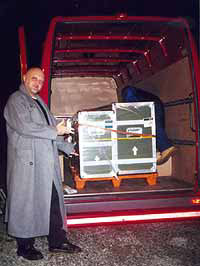The
score is, to a great extent, the sound of the way you want
the audience to feel. It also creates a tone for the entire
piece, setting the stage in a very subtle way. I have always
hated most of the music that went into westerns because
it always seemed to be trying so hard to be "western" that
it painted itself into a corner when it came to expressing
certain emotions -- actually that is true about a lot of
issues surrounding westerns in both fiction and drama. The
composition and instrumentation of western scores rarely
have anything to do with the kind of music that was being
played at the time, so in my mind they are pretty useless.
Phil came up with a sound that communicated a feeling of
the actual historical period while still maintaining enough
complexity to get to all the nuances of feeling that were
hiding in the production. It was a wonderful collaboration;
we would give Phil pieces of the show, he would write the
music and, if necessary, we would edit around his work so
that he was never pressed for time, or mix around his work
so that, whenever possible, you could hear the meaningful
parts. It was an opportunity that you really never get in
film where the picture is like a conductor, marking out
the time available with dictatorial authority.
 The
unique sound developed for Son of a Wanted owes a
lot the the instruments chosen to play the various themes
and bridges. In addition to the traditional violin, chello
and bass strings, a variety of different pianos were used
to add a haunting and historic feeling to the music. Several
different guitars were also used, sometimes alone and sometimes
in conjunction with one another to give the score an enormous
depth and range.
The
unique sound developed for Son of a Wanted owes a
lot the the instruments chosen to play the various themes
and bridges. In addition to the traditional violin, chello
and bass strings, a variety of different pianos were used
to add a haunting and historic feeling to the music. Several
different guitars were also used, sometimes alone and sometimes
in conjunction with one another to give the score an enormous
depth and range.
Two
the most interesting instruments included a mallet piano
and a Chamberlin piano. The Former is literally a piano
frame stripped of the box and legs. The strings are wedged
and dampered with rubber and are struck with felt mallets.
The sound is a very unique, almost mechanical sound which
really helps imply the appropriate time period to the music.
It makes the music sound somehow, as if it were really recorded
in the 1880's. The Chamberlin is one of the first music
samplers which could playback recorded sounds by simply
playing the keys of a piano. This breakthrough would allow
a musician to play a flute or the drums without actually
having to learn each instrument.
As
with our Sound Effects, Phils' music is extremely detailed
and often heavily layered, with several instruments playing
similar themes and others brought in to fill in spaces or
add counterpoint. It was really fascinating to work with
the raw tracks during the Mix of the show as we could adjust
each musical element separately, allowing us a fantastic
amount of flexability. It was really funny hear myself in
Phils' studio shaking my head and saying "I don't know
how you do it" only later to have Phil listening to
a complicated sound effects scene and saying "I don't
know how you do it!"
Once
the score was finished we MIXED
the show and prepared it for mastering.
